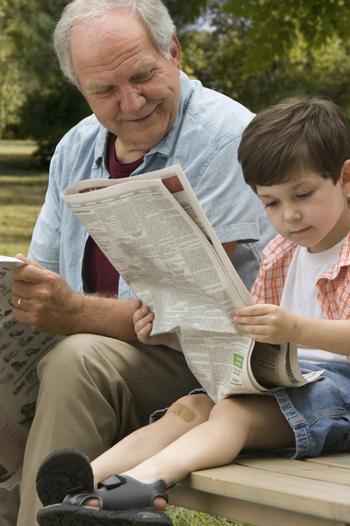The paper's here
Duration/age

Do you get the newspaper delivered to your home? If you do, you can talk to your child about what is in the paper and how to find different information.
The paper’s here. We can look in the entertainment section to see when the movie is on that you want to see. The content index on page 2 will tell us where to find the entertainment section.
Aunty Jacki had a baby. We might be able to find out what she called the baby by looking at the birth announcements in the back of the paper. The births are included in the personal notices. We need to look that up in the paper’s index.
As you look through the paper with your child talk about the different things you find on each page. Some pages have a mixture of articles, pictures and advertisements. Other pages just have columns of writing. Explain to your child that when an article has a picture it is telling the reader that it is an important article. Some pictures might just be part of an ad.
Let’s look at the front page first. The front page will give us a snapshot of what articles will be in the paper.
Can you see that some of the writing is very big and dark? The writer did that to tell you what the article is about and to draw your attention to the heading.
Materials you will need
- A newspaper
Alternative tools
- Local paper
- School newsletter
Skills this activity improves
Why does this matter?
Talking to your child about the newspaper and how it is organised helps them to develop an understanding of how written information is grouped on a page. This is called ’concepts of print’.
When your child looks at and reads the paper with you, they are developing an understanding of the different types of text or writing around them and how it is organised. As they look at the pages they will begin to see that writers use different ways to draw the reader’s attention to their writing. Sometimes they will add a picture or use a large bold heading. Other times they will change the font to make it stand out on the page.
As you look at the paper together your child is developing an understanding of how a newspaper is organised and the different ways to navigate it. They will be learning that a paper has a front and a back and that each page is numbered. As they look inside the cover of the paper they will see that there is an index that shows where section and page information can be found. This is different to a novel or a picture book.
What does this lead to?
As your child grows older, understanding the different ways language can be presented will help them to make decisions on how to organise or record their thinking.
By reading stories, books and newspapers, children experience that the picture, image or design gives greater meaning to the words on the page. Usually the image will connect to those words and lead the reader to the next part of the story. The image helps the reader to understand how they should feel during the story. The colours that are used or the facial expressions shown might be there to help create a happy feeling or a sad tone.
Looking through the newspaper with your child helps them to see the difference between fiction and non-fiction and the different ways information is organised. As you flip through the paper your child will see that the pages are numbered and titled. This helps readers to know where to find information. Using the index at the front of the paper shows your child that they do not need to look at every page to find specific information.
Language to use
- Paper, newspaper, local paper
- Page, cover, title, article, story
- Advertisement
- Author, illustration, picture
- Font, word, sentence, punctuation
- Magazine, lift-out section, columns, index
- Feature article, headline
Questions to use
- What section of the paper would I look in if I wanted to buy a car?
- Do all papers have the same stories?
- Why do we need an index?
- Why does the paper have more pages on some days?
Useful tips
- You might also like to take a look at the activities Exploring junk mail and Make your own books.
- Look through the paper before sharing it with your child. Sometimes there will be pictures that can be very distressing for children.
- Sometimes children will not want you to read all the words of the story and just want you to talk about what they see on each page. This is great too as it is the beginning of understanding how pictures add meaning to the story.
- Give your child access to a wide range of books that include fiction and non-fiction. Take a trip to the local library to find new and interesting books.
- Remember to talk to your child in your home language.
More ideas
Encourage your child to help you look through the paper to find special activities you can do together. Often during the holidays the paper will have a school holiday section.
Variation by age
Three to five year olds
- Make your own family newspaper to send to family and friends.
- Look at magazines and junk mail together. Pick out the features that are the same, like pictures and page numbers.


